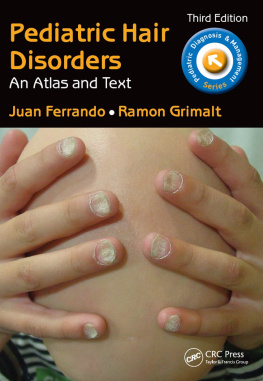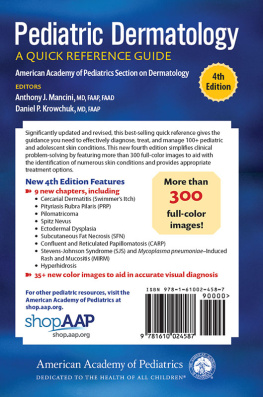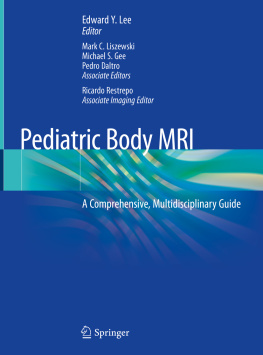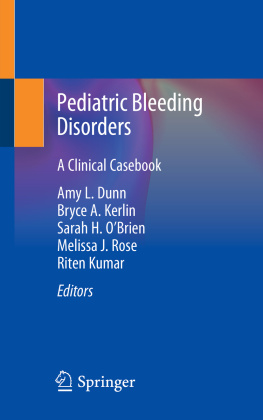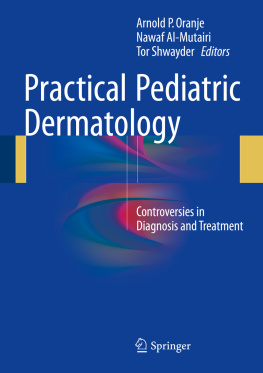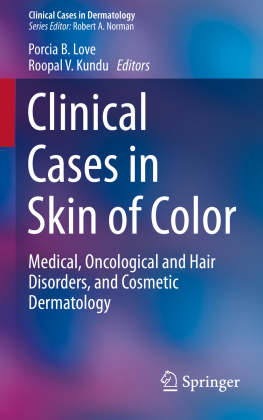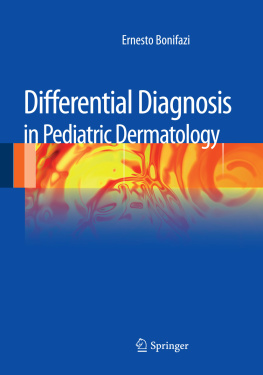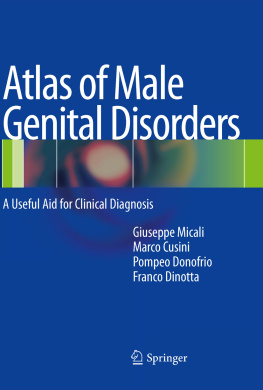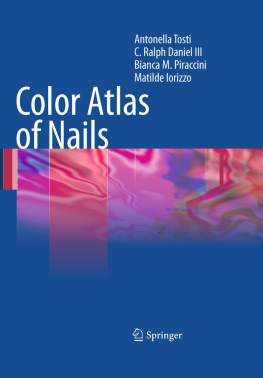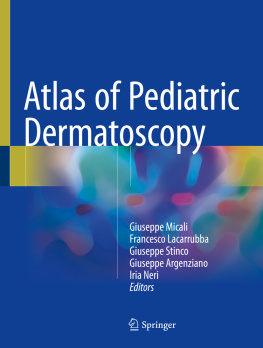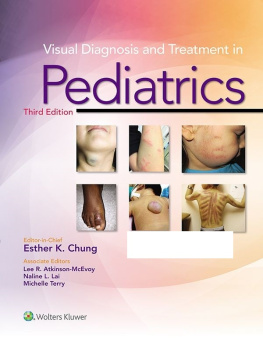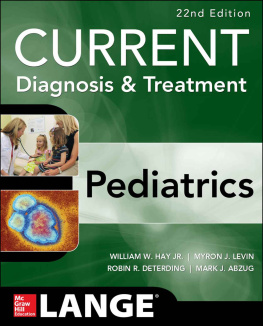CONTENTS
Page List
Guide

Third Edition
Pediatric Hair Disorders
An Atlas and Text
Pediatric Diagnosis and Management
Series Editors: James F. Bale Jr. and Stephen D. Marks
NEW AND FORTHCOMING TITLES
James F. Bale, Jr., Joshua L. Bonkowsky, Francis M. Filloux, Gary L. Hedlund, Paul D. Larsen, and Denise C. Morita, Pediatric Neurology, Second Edition
Robert Baran, Smail Hadj-Rabia, and Robert Silverman, Pediatric Nail Disorders
Juan Ferrando and Ramon Grimalt, Pediatric Hair Disorders: An Atlas and Text, Third Edition
Chloe Macaulay, Polly Powell, and Caroline Fertleman, Learning from Paediatric Patient Journeys: What Children and Their Families Can Tell Us
Stephan Strobel, Lewis Spitz, and Stephen D. Marks, Great Ormond Street Handbook of Paediatrics, Second Edition
Third Edition
Pediatric Hair Disorders
An Atlas and Text
Juan Ferrando, PhD, MD
Consultant in Dermatology
Hospital Clnic
and Associate Professor of Dermatology
Universitat de Barcelona, Spain
Ramon Grimalt, PhD, MD
Associate Professor of Dermatology
Faculty of Medicine and Health Sciences
Universitat Internacional de Catalunya
Barcelona, Spain

CRC Press
Taylor & Francis Group
6000 Broken Sound Parkway NW, Suite 300
Boca Raton, FL 33487-2742
2017 by Taylor & Francis Group, LLC
CRC Press is an imprint of Taylor & Francis Group, an Informa business
No claim to original U.S. Government works
Printed on acid-free paper
Version Date: 20160620
International Standard Book Number-13: 978-1-4987-0777-0 (Paperback)
This book contains information obtained from authentic and highly regarded sources. While all reasonable efforts have been made to publish reliable data and information, neither the author[s] nor the publisher can accept any legal responsibility or liability for any errors or omissions that may be made. The publishers wish to make clear that any views or opinions expressed in this book by individual editors, authors or contributors are personal to them and do not necessarily reflect the views/opinions of the publishers. The information or guidance contained in this book is intended for use by medical, scientific or health-care professionals and is provided strictly as a supplement to the medical or other professionals own judgement, their knowledge of the patients medical history, relevant manufacturers instructions and the appropriate best practice guidelines. Because of the rapid advances in medical science, any information or advice on dosages, procedures or diagnoses should be independently verified. The reader is strongly urged to consult the relevant national drug formulary and the drug companies and device or material manufacturers printed instructions, and their websites, before administering or utilizing any of the drugs, devices or materials mentioned in this book. This book does not indicate whether a particular treatment is appropriate or suitable for a particular individual. Ultimately it is the sole responsibility of the medical professional to make his or her own professional judgements, so as to advise and treat patients appropriately. The authors and publishers have also attempted to trace the copyright holders of all material reproduced in this publication and apologize to copyright holders if permission to publish in this form has not been obtained. If any copyright material has not been acknowledged please write and let us know so we may rectify in any future reprint.
Except as permitted under U.S. Copyright Law, no part of this book may be reprinted, reproduced, transmitted, or utilized in any form by any electronic, mechanical, or other means, now known or hereafter invented, including photocopying, microfilming, and recording, or in any information storage or retrieval system, without written permission from the publishers.
For permission to photocopy or use material electronically from this work, please access www.copyright.com (http://www.copyright.com/) or contact the Copyright Clearance Center, Inc. (CCC), 222 Rosewood Drive, Danvers, MA 01923, 978-750-8400. CCC is a not-for-profit organization that provides licenses and registration for a variety of users. For organizations that have been granted a photocopy license by the CCC, a separate system of payment has been arranged.
Trademark Notice: Product or corporate names may be trademarks or registered trademarks, and are used only for identification and explanation without intent to infringe.
Visit the Taylor & Francis Web site at
http://www.taylorandfrancis.com
and the CRC Press Web site at
http://www.crcpress.com
To my wife, Dra. Esperanza Navarra; to my sons and daughter, David, Marc, and Anna; and to my granddaughter, Jana.
Juan Ferrando
To my wife, Dra. Alicia Mirada, and to my daughters, Rita and Gina.
Ramon Grimalt
Contents
Hair diseases represent a significant portion of cases seen by pediatric dermatologists. It is, therefore, a great pleasure to see the publication of this diagnostic atlas for pediatric hair disorders. The authors are well known in international trichology, especially in the field of hair problems in childhood. This book is easy to follow and represents a timely contribution to both clinical dermatology and pediatrics.
During the past decade, many investigators involved in clinical and basic research have been attracted by the field of hair disorders. In particular, molecular analysis of genetic hair disorders is developing rapidly. The examination of the status of hair growth, including microscopic analysis of hair shafts, represents a visual approach that may yield important hints for the diagnosis of complex genetic syndromes. This book will help both dermatologists and pediatricians improve their skills in the differential diagnosis of hair diseases.
Why pediatric trichology? For many reasons it is necessary to treat the special problems of hair diseases of children. For example, the full-blown picture of Menkes kinky hair disease is virtually never seen in adult patients. Loose anagen hair very rarely occurs in adults, and trichotillomania is far more frequently seen in childhood.
Dermatologists are in the enviable situation of being able to study many disorders with simple diagnostic techniques. Hair is easily accessible to examination but, paradoxically, hair examination is often ignored by non-dermatologists. The present text will serve as an important tool in the diagnostic processes used in daily practice, and it will help, for example, to distinguish certain acquired and genetically determined hair diseases. The informative iconographic material of this book will stimulate and encourage physicians to perform microscopic analyses of hair shafts and cooperate with dermatologists experienced in this special field of medicine.
It is a privilege to be associated, even in this peripheral form, with this text that will be a most welcome addition for all those dealing with hair diseases of children.
Rudolf Happle, M.D.
Marburg, Germany
Pediatric trichology covers a wide field of study that includes pediatric and dermatological cases. It comprises extremely common entities (alopecia areata, trichotillomania) and others that are rare and more difficult to diagnose (hair dysplasias, genodermatosis). In many of the clinical pictures, hair alteration (diffuse or localized, alopecia, cicatricial or non-cicatricial, acquired or congenital) is a fundamental clue for clinical diagnosis (Menkes syndrome, Netherton syndrome, trichothiodystrophy). Knowledge of the possible clinical associations in all these entities (follicular hyperkeratosis, ichthyosis, cataracts, seizures) may also contribute to a diagnosis.

